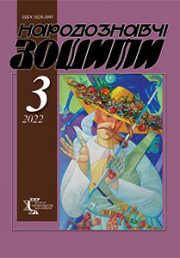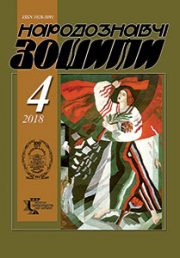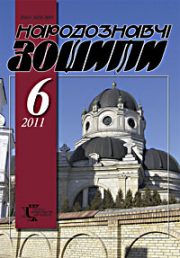The Ethnology Notebooks. 2018, 2 (140), 363—371.
UDK 7.041.2 / 7 : 75.053](477.83/.87)
DOI https://doi.org/10.15407/nz2018.02.363
Received 11.01.2018
TRADITION OF HOME ICONS ON GLASS: REVIVAL, INTERPRETATION (on the example of lviv cell)
ORCID ID: https://orcid.org/0000-0002-4717-4396
Triska Oksana, candidate of study of art,
Senior Researcher
of department of folk art
of Institute of Ethnology
of the National Academy of Sciences of Ukraine.
Svobody Avenue 15, 79000, Lviv, Ukraine.
Contacts: e-mail: oksana_triska@yahoo.de.
Abstrakt. In the paper revival features of the ancient Hutsul-Pokuttia’s painting on the glass tradition is discussed. Creation of the second half of the XIX century icon replicas attests Ukrainian artists conscious appeal to ethnic sources, which has given an integral basis not only for copying, but also for creative interpretations. Trend to mass replication of the best examples of folk art facilitate the formation Ukrainian identity symbolic markers.
Keywords: folk icon on the glass, creative interpretation, art stylistic, replica, national identity.
REFERENCES
Vytvyts’ky,j S. (1993). Istorychnyj narys pro hutsuliv. Kolomyia: Svit [in Ukrainian].
V’iacheslavova, O. (2010). Neotradytsionalizm u konteksti ukrains’koho postmodernu. Artaniia, 3, pp. 16—17 [in Ukrainian].
Romaniv-Triska, O. (Ed.). (2008). Narodna ikona na skli: al‘bom. Kyiv : Instytut kolektsionerstva pry NTSh [in Ukrainian].
Otkovych, V.P. (1988). Zhyvopys na skli — tradytsii ta suchasnist‘: kataloh vystavky. L’viv : In-t mystetstvoznavstva, fol’kloru ta etnohrafii im. M. Ryl’s’koho [in Ukrainian].
Romaniv-Triska O. (2008). Zakhidnoukrains’ke maliarstvo na skli XIX — pochatku XX stolittia. In Narodna ikona na skli: al‘bom. Kyiv: Instytut kolektsionerstva pry NTSh, pp.13—33 [in Ukrainian].
Svientsits’ka, V. (1990). Maliuvannia na skli: kataloh vystavky z fondiv Muzeiu ta zbirok l‘vivs‘kykh kolektsioneriv. L’viv: NML [in Ukrainian].
Shukhevych, V. (1997). Hutsul‘schyna. Repryntne vidtvorennia vydannia 1899 roku. Verkhovyna (Vol.1). [in Ukrainian].
Hotsaliuk, A.A. Neotradytsionalizm iak iavysche dukhovnoi kul’tury. Retrieved from: http://www.stattionline.org.ua/obraz/33/2112-neotradicionalizm-yak-yavishhe-duxovno%D1%97-kulturi.html [in Ukrainian].






